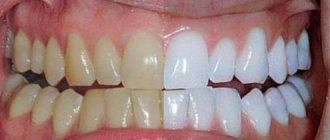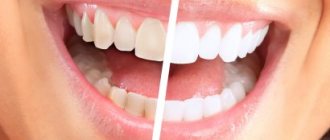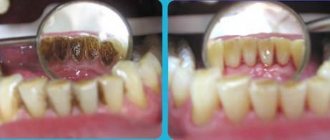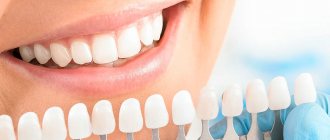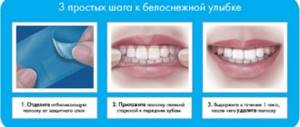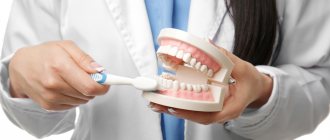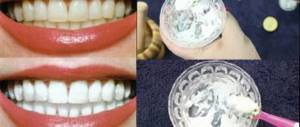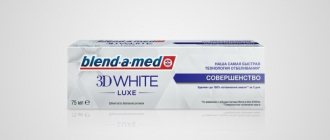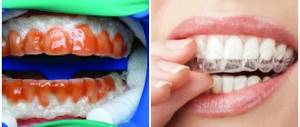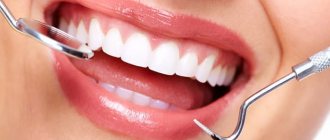Seal
A defect in which enamel and dentin change color is called “tetracycline teeth” in dental practice. This is due to the fact that with long-term treatment, this antibiotic is deposited in bone tissues and colors them gray, brown, yellow, or brown. It is important to note that the drug is not removed over time, and therefore the staining is permanent.
Kabanova Natalya Aleksandrovna – dentist-therapist at the Dentoclass clinic.
Tetracycline and its effects
Tetracycline is a broad-spectrum active ingredient, therefore it is present in many medications as one of the main components. The production of preparations with tetracycline began in 1950, but it was only possible to determine that tooth enamel acquires a gray or yellow tint under its influence in 1980. It turned out that the effect of tetracycline on tooth enamel does not affect all age categories of patients. This caused such a long delay in identifying the cause.
Damage to tooth enamel by tetracycline is observed in children under 14 years of age. After the drug penetrates the body, it begins to mineralize with calcium, which is found in bone tissue. This provokes various disorders in the bone structure, causing enamel hypoplasia. But the most interesting thing is that such an effect on tissues can only occur during their formation. Therefore, children, as well as mothers who are carrying a child, are at risk.
Tetracycline cannot cause the development of caries or other serious dental diseases. Therefore, there is no pain when tooth enamel is damaged by this component. But the drug affects the formation of hard tissues. The extent of the pathology will depend on the amount of accumulated tetracycline in the body. A small dose of the drug can only change the color of the enamel, but a large dose can cause initially incorrect development of the tooth covering.
Definition
As the name implies, the term “tetracycline teeth” or, in scientific terminology, tetracycline staining of dental tissue, is directly related to the name of the antibiotic tetracycline that causes it.
This drug, by binding with calcium, forms mineral compounds that change the structural composition of the enamel of the developing tooth.
Doctors attribute the effect of tetracycline teeth to hypoplasia - a non-carious lesion of hard tissue. It may manifest itself as partial damage to the enamel or a complete change in color. Also, in the case of constant use of tetracycline, serious damage in the form of underdevelopment of tooth enamel is possible.
Main causes of the disease
The main reason for the development of tetracycline teeth is the ingestion of tetracycline into the body. And it doesn’t matter in what doses this drug entered the body. The method of its entry also becomes unimportant - medications for external or internal use.
Drugs containing tetracycline are often used in the treatment of pneumonia, cholera, various skin rashes, and also for the treatment of ulcers. Self-treatment of these diseases is contraindicated, as they are considered complex and require complex treatment. Therefore, the specialist who prescribes a course of medication is obliged to warn the patient about the potential side effects associated with the use of tetracycline.
The instructions for all drugs containing tetracycline indicate that it is strictly contraindicated to take:
- During pregnancy and lactation. The drug spreads throughout the mother's body, entering the growing baby's body.
- Children under 14 years of age. Until this year, bone tissue develops, which is strongly susceptible to the influence of tetracycline.
An interesting fact is that tetracycline teeth can form up to 14 years of age, but can appear much later. The following factors contribute to this:
- unexpected reaction of the body;
- prolonged exposure to the sun;
- influence of food dyes;
- influence of chemical dyes;
- allergic reactions;
- prolonged use of medications containing tetracycline;
- time flow.
The drug can accumulate in the human body. It is impossible to remove it. Leads to staining of both the visible and inner layers of enamel. Therefore, treating the problem will require an integrated approach. Most often it consists of two stages - whitening and strengthening of bone tissue.
Prevention measures
What should you do to avoid tetracycline staining of teeth? Most importantly, if you do not want your child to have dark spots, try not to take this medicine during the second and third trimesters of pregnancy, during lactation (since the drug enters the child’s body through breast milk). Fortunately, there are many other modern drugs with a wide range of bacteriostatic effects.
It should also be remembered that permanent teeth can also become stained. Therefore, immediately discuss with your pediatrician all possible factors affecting the growing body. As well as the consequences and alternative drugs if a child under 12 years of age is prescribed the above-mentioned antibiotic in the form of tablets or eye ointment.
Sources:
- https://dentazone.ru/kosmeticheskaya/otbelivanie/tetraciklinovye-zuby.html
- https://anZub.ru/lechenie-zubov/diskolorit-izmenenie-cveta-zubnojj-ehmali/
- https://dentaplas.ru/izmenenie-cveta-zubov
- https://CreateSmile.ru/tetraciklinovye-zuby/
- https://dentospas.ru/inf/bolezni-zubov/tetraciklinovye-zuby/
- https://dr-zubov.ru/lechenie/zuby/opasnost-antibiotiki-tetraciklinovye.html
- https://stomatologiya-stavropol.ru/stati/kak-spasti-tetratsiklinovye-zuby/
- https://MikDent.ru/stomatolog/bolezni/tetratsiklinovye-zuby.html
- https://mnogozubov.ru/tetraciklinovye-zuby/
Tetracycline teeth: signs and diagnosis
Symptoms of the disease can have a very diverse pattern of manifestation. This will depend on the dose of the drug taken. May be observed:
- Partial pigmentation. The shade of tooth enamel changes in individual areas on the teeth.
- There was an absolute change in the shade of tooth enamel on all dental units.
- The shade of enamel changes in the cervical parts of the dentition (the border between the teeth and gums).
- Too large a dose of drugs at an early age and at the stage of fetal formation is reflected by underdevelopment of the enamel and a subsequent change in its color.
When the disease occurs, the shades of enamel become as follows:
- yellow;
- gray or yellow-gray;
- dark gray, gray-brown;
- orange and even brown.
The color may not necessarily be uniform. It can appear in different shades over the entire surface of the tooth. But with almost all tetracycline lesions, a change in color also occurs in the inner layer of the incisor
The intensity, location and degree of staining directly depends on age and duration of medication use. Most often, the part of the crown that undergoes changes is the part in which intensive formation took place while taking antibiotics. For example, taking the drug by a pregnant woman will result in the problem of staining the child’s teeth in the cutting part. The chewing surface of the lateral teeth and the cervical area of the front teeth begin to form already in the first months of the baby’s life, and therefore are the first to be exposed to danger.
The main thing that a specialist must do before making a diagnosis is to exclude any factors that could affect the change in the color of the enamel, and also make sure that the symptoms were provoked specifically by medications of the tetracycline group. The fact is that a change in the color of the enamel could also be caused by drinking water with a high fluoride content, as well as taking iron. In addition to a thorough external examination, the specialist will need to study the patient’s clinical picture, which would indicate taking tetracycline drugs.
To confirm the diagnosis, a specialist may prescribe professional diagnostics using ultraviolet light. The method uses a lamp that emits ultraviolet rays, when exposed to which tetracycline spots fluoresce (glow). Only after confirmation of the diagnosis is comprehensive treatment prescribed.
Expert opinion
Roman Borisovich Alekperov
orthopedic dentist
Experience: 24 years
Today there are various ways to solve the problem of tetracycline teeth. Starting from ceramic veneering to covering teeth with crowns. In any case, you can choose an option that suits your budget. Don’t waste time, get your teeth in order, and get rid of aesthetic problems and psychological discomfort that this dental pathology causes.
Treatment methods for tetracycline teeth
Due to the fact that tetracycline provokes staining of tooth enamel from the inside and outside, therapy will take a long time. The main goal of this therapy is to whiten teeth and strengthen enamel. The entire therapeutic process consists of several mandatory stages:
- complete sanitation in the oral cavity;
- mandatory professional cleaning;
- enamel remineralization process;
- teeth polishing followed by fluoride varnish coating.
Only an integrated approach from all of the above procedures will give the most effective result in the fight against tetracycline teeth. More details about each stage.
Sanitation of the oral cavity
Almost all dental procedures with teeth begin with sanitation of the oral cavity. Tetracycline damage to teeth is no exception. Before you start fighting tetracycline teeth, you will need to cure all existing dental diseases.
Why do you need professional cleaning?
Professional cleaning allows you to remove all soft and hard deposits from the enamel surface. In the future, this will make it possible to accurately diagnose oral problems and also contribute to treatment. Medicinal and bleaching agents can easily penetrate into the densest layers of dental tissue.
How does enamel remineralization work?
Insufficient mineralization of enamel during its formation is the first reason why tetracycline teeth are formed. Therefore, one of the important stages of treatment is the restoration of minerals and strengthening of dental tissues.
For these purposes, preparations containing fluorine, phosphorus and calcium are used. Phono- or electrophoresis procedures may be prescribed. Applications with solutions such as sodium fluoride or calcium gluconate have proven themselves well. The course consists of 15–20 visits. Procedures can be prescribed every other day or daily.
If the enamel pigmentation was insignificant, applications with the above drugs can be carried out at home independently.
Teeth polishing followed by fluoride varnish coating
After all whitening and remineralization procedures, it is recommended to coat the tooth enamel with fluoride varnish. This drug consists of fir balsam, a mixture of sodium fluoride and other components that will be useful for gums and teeth. Fluoride varnish looks like a dark brown liquid, viscous in consistency. The effect of fluoride varnish on tooth enamel and gums is as follows:
- A hard layer is created on the surfaces of the teeth, which prevents the loss of minerals. Its task is to protect the enamel from the effects of ultraviolet radiation, damage to the top layer of the tooth that can be caused by solid foods, and temperature changes (hot and cold food).
- Saliva contains calcium, which, when combined with fluoride, nourishes the tooth, strengthening it from the outside.
- The drug suppresses the vital activity of organisms in the oral cavity, which contribute to the destruction of enamel.
Therapy is the first step in the fight against tetracycline staining of teeth. For most patients, cosmetic correction of dental defects will also be required.
Reviews
Tetracycline teeth are a fairly common problem, despite the specific causes of its occurrence. Many people have already experienced procedures to restore normal color and structure to teeth that have been damaged by taking tetracycline.
You can share your experience regarding this by leaving a comment on this article.
In conclusion, a short video in which you can tell us how tetracycline teeth are treated in Spain:
If you find an error, please select a piece of text and press Ctrl+Enter.
Tags tetracycline teeth
Did you like the article? stay tuned
Previous article
Straumann implants (Strauman): advantages, description of varieties
Next article
Correct bite in humans: photos, varieties
How to whiten tetracycline teeth
All methods of primary therapy are aimed at maximally strengthening and preventing further destruction and erosion of the enamel. To eliminate cosmetic defects, you will need to undergo cosmetic restoration, which is performed using several methods (restoration or bleaching). The choice of method will depend on the nature of the staining of dental crowns and the degree of their damage.
Cosmetic restoration of dental crowns
This method can correct the situation when tetracycline pigmentation occurs only in certain areas of the surface of the tooth enamel. For restoration dentistry, they offer 3 options: the use of composite material, fixation of veneers, partial prosthetics. More details:
- Application of photocomposite. Photocomposite material has a resin-like consistency. It is applied to the surface of the damaged tooth and irradiated with a halogen lamp. Irradiation lasts about 30 minutes. This allows the material to harden, forming a strong crust on the surface of the tooth.
- Cosmetic restoration with veneers involves fixing ceramic plates to the front surface of the tooth. This type of restoration is the most expensive method, but it allows you to acquire a Hollywood smile for a long time.
- Prosthetics of individual dental units is performed when other restoration methods are powerless.
Whitening methods
Teeth whitening damaged by tetracycline is carried out in cases of uniform staining of the enamel. For cosmetic whitening, internal or vital methods are used.
If deep-lying tissues are damaged, internal bleaching is performed. Special preparations are injected into the pulp cavity to whiten the tooth from the inside.
External whitening is carried out using zoom (ZOOM) or laser - hardware methods that allow you to whiten tooth enamel up to 12 tones. The result obtained lasts for several years. Afterwards the procedure will need to be repeated. More details about each method:
- Zoom whitening occurs by applying urea or hydrogen peroxide to tooth enamel. After this, the surface is irradiated with a zoom (special lamp). Under its influence, oxygen begins to be released from the applied preparations, which whitens tetracycline stains. For patients with a low pain barrier, the procedure is painful. Others feel minor discomfort. The procedure lasts about 2 hours, and upon completion the sensitivity of the dental tissues increases.
- Laser teeth whitening is a more gentle procedure. The surface of the tooth enamel is covered with a special photosensitive dental gel, which also begins to release oxygen under the influence of laser beams. The procedure lasts about 30 minutes, but several approaches may be required to get a good result.
Whitening with ZOOM technology is estimated at $300–500, but the price of laser whitening can vary from $160 to $500. This difference in the cost of laser whitening is due to subsequent remineralization, which some clinics include immediately in the cost of the procedure, while others ask to pay separately.
The only preventative method to avoid damage to tooth enamel by tetracycline is to try to avoid taking medications containing it.
Sources used:
- Maksimovsky Yu.M., Mitronin A.V. Therapeutic dentistry / M.: Geotar-Media, 2012.
- Therapeutic dentistry. Periodontal diseases: textbook: in 3 hours / Ed. G. M. Barera. - M.: GEOTAR-Media, 2013.
- Rational pharmacotherapy in dentistry: A guide for practitioners / Edited by G.M. Barera, E.V. Zoryan. – M., Littera, 2006
- Health Committee of St. Petersburg
Will whitening help?
A tetracycline “smile” can be whitened only if the color is uniform and not very dark. Before whitening, teeth are remineralized, i.e. restoration of their structure by taking minerals.
The method and duration of whitening procedures are prescribed individually. In case of minor damage, procedures are carried out at home using special pastes. More intense staining is eliminated through ultrasonic cleaning, which can whiten the surface by 1-2 tones; laser and ZOOM whitening are the most effective; these procedures help lighten the surface by 8-12 tones.
In cases where whitening cannot be helped, restoration of tetracycline teeth using veneers is used, you can see the result in the photo below.
